Order Ciconiiformes | Phylum Chordata Family Ciconiidae Scientific name Ciconia nigra Rank Species | |
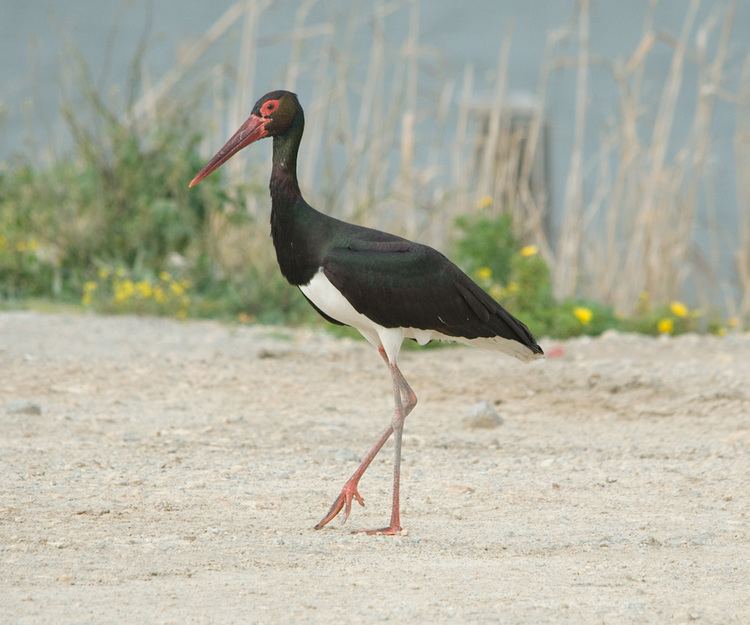 | ||
Similar Bird, White stork, Ciconia, Stork, Lesser spotted e | ||
Black storks hunting in shallow waters
The black stork (Ciconia nigra) is a large wading bird in the stork family Ciconiidae. It is a widespread, but uncommon, species that breeds in the warmer parts of Europe (predominantly in central and eastern regions), across temperate Asia and Southern Africa. This is a shy and wary species, unlike the closely related white stork. It is seen in pairs or small flocks—in marshy areas, rivers or inland waters. The black stork feeds on amphibians and insects.
Contents
- Black storks hunting in shallow waters
- Black stork bird s video
- Taxonomy and etymology
- Description
- Distribution and habitat
- Migration
- Breeding
- Parasites
- Works cited
- References
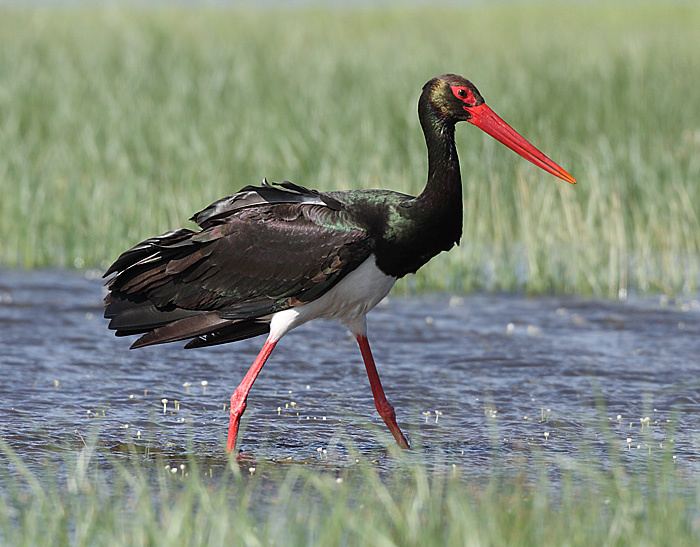
Black stork bird s video
Taxonomy and etymology
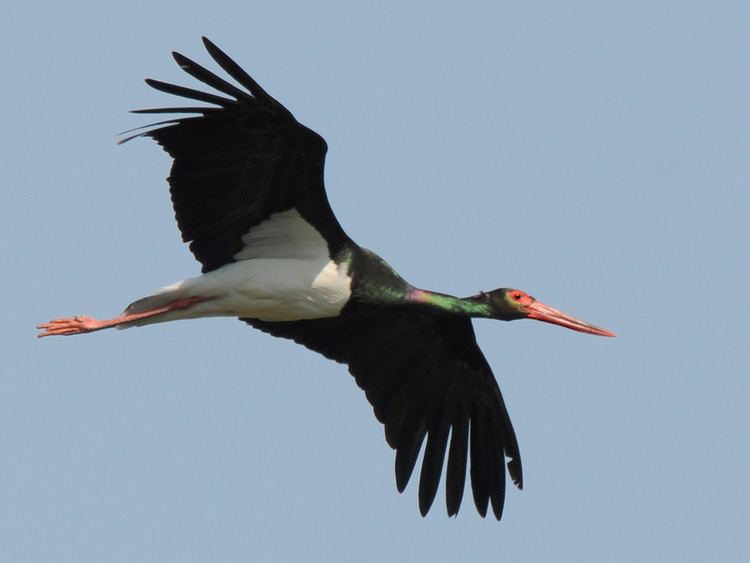
The stork family contains several genera in three major groups: the open-billed and wood storks (Mycteria and Anastomus), the giant storks (Ephippiorhynchus, Jabiru and Leptoptilos), and the "typical storks", Ciconia. The typical storks include the white stork and six other extant species, which are characterised by straight bills and mainly black and white plumage. Within the genus Ciconia, the black stork's closest relatives are the other European species, the white stork and its former subspecies, the black-billed Oriental white stork of east Asia. The black stork was found to be basal in analysis of mitochondrial cytochrome b DNA by Beth Slikas in 1997. Fossil remains have been recovered from Miocene beds Rusinga and Maboko Islands in Kenya, which are indistinguishable from the white and black storks.
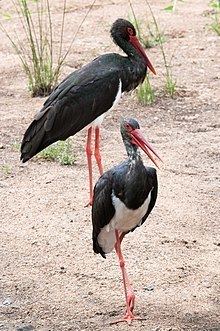
The black stork was one of the many species originally described by Linnaeus in the landmark 1758 10th edition of his Systema Naturae, where it was given the binomial name of Ardea nigra. It was moved to the new genus Ciconia by French zoologist Mathurin Jacques Brisson two years later. Both the genus and the specific names are Latin; Ciconia is "stork" and nigra is "black". The word stork is derived from the Old English word storc, thought to be related to the Old High German storah, meaning "stork", and the Old English stearc, meaning "stiff".
Description
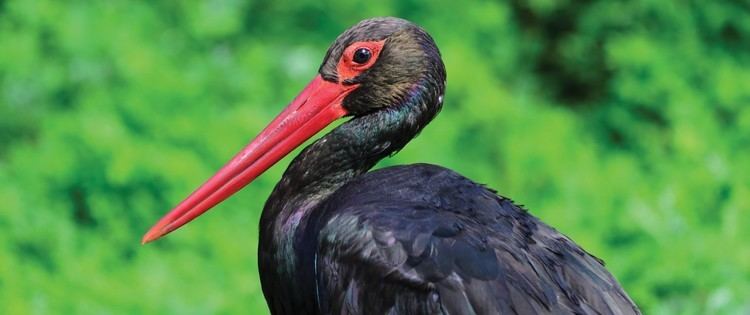
Slightly smaller than the white stork, the black stork is a large bird, 95 to 100 cm (37 to 39 in) in length with a 145–155 cm (4.76–5.09 ft) wingspan, and weighing around 3 kg (6.6 lb). They can stand as tall as 102 cm (40 in). Like all storks, it has long legs, a long neck, and a long, straight, pointed beak. The plumage is all black with a purplish green sheen, except for the white lower breast, belly, axillaries and undertail coverts. The breast feathers are long and shaggy forming a ruff which is used in some courtship displays. The bare skin around its eyes is red, as are its red bill and legs. The sexes are identical in appearance, except that males are larger than females on average.
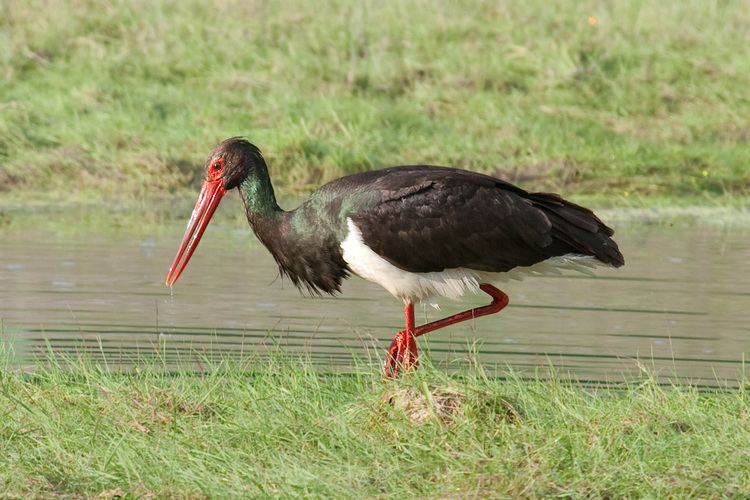
The juvenile resembles the adult in plumage pattern, but the areas corresponding to the adult black feathers are browner and less glossy. The scapulars, wing and upper tail coverts have pale tips. The legs, bill, and bare skin around the eyes are greyish green. It may be confused with the juvenile yellow-billed stork, but the latter has a paler wings and mantle, longer bill, and white under the wings.
It walks slowly and steadily on the ground. Like all storks, it flies with its neck outstretched. It has a rasping call, but rarely indulges in mutual bill-clattering when adults meet at the nest.
Distribution and habitat
During the summer, the black stork is found from Eastern Asia (Siberia and China) west to Central Europe, reaching Estonia in the north, Poland, Lower Saxony and Bavaria in Germany, the Czech Republic, Hungary, Italy and Greece in the south, with an outlying population in Spain and Portugal. They are not abundant in these western parts of their distribution, but more densely inhabit the eastern Transcaucasus. A population of black storks is also resident in Southern Africa.
Preferring more wooded areas than the better known white stork, the black stork breeds in large marshy wetlands with interspersed coniferous or broadleaved woodlands, but also inhabits hills and mountains with sufficient networks of creeks. It inhabits more areas in the Caspian lowlands.
Migration
The black stork is a strong migrant, wintering in tropical Africa, India & Bangladesh. A broad-winged soaring bird, the black stork is assisted by thermals of hot air for long distance flight, although are less dependent on them than the white stork. Since thermals only form over land, storks, together with large raptors, must cross the Mediterranean at the narrowest points, and many black storks can be seen going through the Bosphorus. They fly approximately 100 to 250 km (62 to 155 mi) a day with daily maxima up to 500 km (310 mi).
The storks migrate from the middle of August to the end of September. They return in the middle of March. About 10% of the western storks choose the passage Sicily - Cap Bon, Tunisia. The common route goes over Gibraltar. Many birds are fly around the Sahara next to the coast. Most birds are wintering in the wetlands of Nigeria or Mali. The eastern birds take the route Bosphorus-Sinai-Nile to Africa. Birds that summer in Siberia winter in northern and northeastern India. In Southern Africa, black storks that nest in the central montane areas perform season winter movements to warmer coastal and subtropical zones.
Breeding
The black stork builds a stick nest high in trees or on cliffs. It nests in Central Europe in April to May, and is a winter visitor to northern India, Nepal east to Myanmar.
Black stork parents have been known to kill one of their young, generally the smallest, in times of food shortage to reduce brood size and hence increase the chance of survival of the remaining nestlings. Stork nestlings do not attack each other, and their parents' method of feeding them (disgorging large amounts of food at once) means that stronger siblings cannot outcompete weaker ones for food directly, hence parental infanticide is an efficient way of reducing brood size. Despite this, this behaviour has not commonly been observed.
Parasites
J. Sitko and P. Heneberg suggested that black storks host over 12 helminth species. Cathaemasia hians and Dicheilonema ciconiae were reported to be the dominant ones. Juvenile black storks were shown to host less species, but the intensity of infection was higher in the juveniles than in the adult storks.
